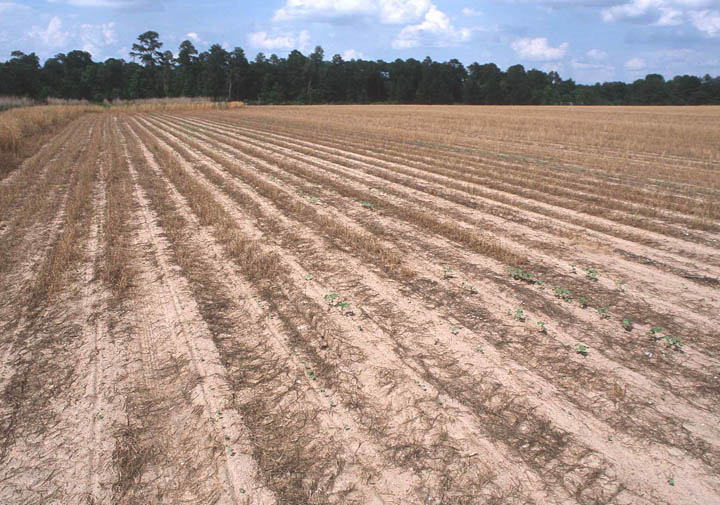
California hits record no-till crop yields in 2011
UC scientists have achieved the same yields in cotton and tomato research plots managed under conservation tillage strategies as they did on adjacent plots using conventional tillage.Researchers harvested 3.4 bales per acre of cotton and 53 tons per acre of processing tomatoes using no-till techniques. Plots managed with conventional tillage practices averaged about 3.4 bales per acre for cotton and 49 tons per acre for tomatoes.
December 22, 2011

University of California scientists have for the first time achieved the same yields in cotton and tomato research plots managed under conservation tillage strategies as they did on adjacent plots using conventional tillage practices.
“The bar has been set,” said UC Cooperative Extension vegetable crops specialist Jeff Mitchell. “After toiling for more than a decade, we’ve finally succeeded in putting the pieces together this past season.”
Researchers harvested 3.4 bales per acre of cotton and 53 tons per acre of processing tomatoes using no-till techniques. Plots managed with conventional tillage practices averaged about 3.4 bales per acre for cotton and 49 tons per acre for tomatoes.
The research was conducted at the UC West Side Research and Extension Center, near Five Points in Fresno County. Scientists established the cotton crop by direct seeding into beds that had not been touched since the preceding tomato crop, except by two herbicide sprays. The 2011 tomato crop was established with a no-till transplanter following the 2010 cotton crop, which had only been shredded and root-pulled under a waiver granted by the California Department of Food and Agriculture’s Pink Bollworm Eradication Program.
The 2011 regime represented the first time since the start of the study in 1999 that the Five Points research team strictly followed no-tillage techniques for both crops. In past years, in which tomato yields reached the mid-60 tons per acre, in-season cultivation for weed control was used. In 2011, however, the goal of going completely no-till was realized in preparation for 2012, when the field will be converted to subsurface drip irrigation for all subsequent no-till plantings. Scientists believe the 2011 tomato harvest for both conventional and no-till plots was lower than in previous years because planting took place April 7 due to weather and scheduling delays.
UC Cooperative Extension agricultural economist Karen Klonsky estimates that switching to no-till production reduced expenditures by about $135 per acre for the tomato crop and about $40 per acre for cotton.
“What we’re trying to do in this research,” Mitchell said, “is to look far into the future and evaluate the true costs and benefits of these alternative systems. Producers, as well as the general public, can then better understand broad future benefits and goals for sustainable crop and resource management, allowing farmers to develop and eventually adopt production practices that might best reach these goals.”
Profitability, resource quality, conservation
Future goals for conservation tillage production systems include profitability, resource quality, conservation, as well as broader ecosystem services.
“No-till makes sense as a means for lowering production costs and cutting dust and greenhouse gas emissions,” Mitchell said. “No-till also improves soil functions, such as increased carbon storage, greater stability of soil aggregates, increased porosity and water infiltration, and a larger population of earthworms.”
The benefits of no-till farming have been recognized by researchers and farmers in other regions, such as the Great Plains and the Pacific Northwest regions of the U.S., across much of Canada, and also throughout large areas of South America.
“These benefits start to pile up pretty fast once longer-term and broader sustainability goals are factored in,” Mitchell said.
Mitchell and his Five Points team are part of California’s Conservation Agriculture Systems Institute (CASI), a diverse group of more than 1,500 farmers, industry representatives, university, Natural Resources Conservation Service and other public agency members. Over the past 10 years, the team has come together to develop information on the true costs and benefits of the production system and irrigation management alternatives and to help develop appropriate sustainability goals for the long haul. For more information on the body of CT research, see the UC Conservation Tillage website at http://ucanr.org/ct.
“One of the things that CASI does is track changes in tillage management practices that are used throughout the San Joaquin Valley,” said Ron Harben, long-time member and former air quality coordinator for the California Association of Resource Conservation Districts. “Our most recent survey for 2010 showed an increase of about 5 percent in no-till and strip-till acreage over previous years. As of 2010, over 47 percent of the cropland in the San Joaquin Valley is using some form of conservation tillage.”
You May Also Like



